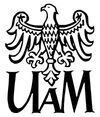and Balkan Europe
by IECOB & AIS Università di Bologna

This area collects information on academic centers, state institutions, political and no profit organizations promoting the exchange of contacts and supporting institutional collaboration
Adam Mickiewicz University in Poznań
Name in Polish: Uniwersytet Adama Mickiewicza w Poznaniu

Description: Adam Mickiewicz University in Poznań (Polish: Uniwersytet im. Adama Mickiewicza w Poznaniu) is one of the major Polish universities, located in the city of Poznań in western Poland. It opened on May 7, 1919, and since 1955 has carried the name of the Polish poet Adam Mickiewicz.
The university was ceremonially opened on May 7, 1919 (the 400th anniversary of the foundation of Poznań's Lubrański Academy). It was originally called Wszechnica Piastowska ("University of the Piasts" – wszechnica being a less common Polish word for "university"), and in 1920 was renamed Uniwersytet Poznański ("Poznań University"). For the first 20 years it educated students in law, economy, medicine, humanities, mathematics, natural sciences, agriculture and forestry.
In 1920 famous sociologist Florian Znaniecki founded the first Polish department of sociology at the university, one of the first such departments in Europe. In the same period of the university's history, botanist Józef Paczoski founded the world's first institute of phytosociology.
After the invasion of Poland, Poznań was annexed by Germany and the University was closed by the Nazis in 1939. It was reopened as a German university in 1941, which operated until 1944. Staff and students of the Polish university, many of them resettled by Germans to Warsaw, opened an underground Polish "University of the Western Territories" (Uniwersytet Ziem Zachodnich), whose classes met in private apartments (see Education in Poland during World War II). The Polish university reopened, in much smaller form, after the end of World War II. In 1950, the Medical Faculty, including the Dentistry section and the Faculty of Pharmacy, were split off to form a separate institution, now the Poznań University of Medical Sciences. In 1955 Uniwersytet Poznański adopted a new patron, the 19th-century Polish Romantic poet Adam Mickiewicz, and changed to its current name.
The university's central administrative building is Collegium Minus, on the west side of Adam Mickiewicz Square at the western end of the street Święty Marcin. (This is one of a group of buildings, including the Imperial Palace, built in the first decade of the 20th century while Poznań was still under German rule; it originally housed a Royal Academy.) Adjoining this is the Aula, which is frequently used for ceremonies and for classical music concerts, and Collegium Iuridicum (accommodating the law faculty). Some teaching takes place in Collegium Maius, another of the aforementioned group of buildings (on ul. Fredry), although this is mainly used by the medical university. Other buildings in the city centre include Collegium Historicum on Święty Marcin, Collegium Novum (used mainly for language teaching) on Al. Niepodległości, and the university library on ul. Ratajczaka.
The university also uses a number of other buildings in southern and western districts of Poznań. However it is strongly developing its site at Morasko in the north of the city. As of 2006, the faculties of physics, mathematics and computer science, biology, geographical and geological science had moved to the new location.
The university also has external branches in other towns of western Poland, including Kalisz, Ostrów Wielkopolski and Słubice.
Languages: Chinese, English, Polish








